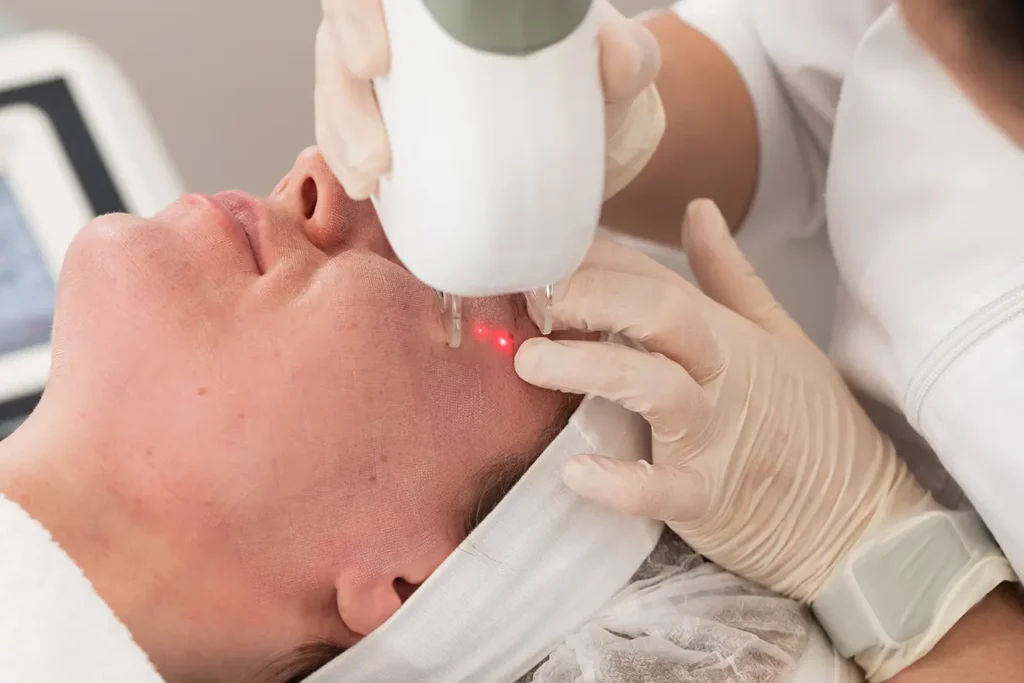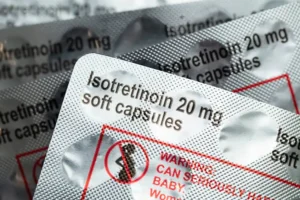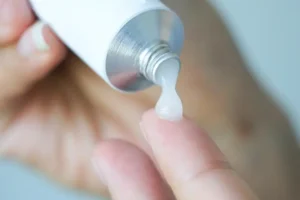Since Theodore H. Maiman’s creation of the first laser in 1960, advancements in laser treatments have led to the development of various methods tailored to address specific skin concerns. Among these, ablative and non-ablative lasers stand out as the most popular options for acne scar management.
We will delve into the differences between ablative, non-ablative and fractional lasers, explore their effectiveness on different types of acne scars, and provide insights into their overall role in skin rejuvenation.
How Ablative, Non-Ablative, and Fractional Lasers Work on Skin
Laser treatments involve the use of focused beams of light, designed to interact with the skin in specific ways. When applied to the skin, lasers can have various effects, such as:
- Reflection: Some of the laser light may bounce off the skin without penetrating it. This effect is minimized in most fractional lasers and non-ablative lasers, which are designed to focus energy deeper into the skin.
- Scattering: Laser beams can disperse beyond the targeted area, reducing the concentration of energy. This is more common in non-ablative lasers, as they are less aggressive and work by heating the skin’s deeper layers without damaging the surface. Ablative lasers, in contrast, have more focused energy, reducing the scatter effect.
- Penetration: The laser light can pass through the skin’s surface to reach deeper layers. Ablative lasers, such as CO2 and Erbium-YAG lasers, as well as fractional lasers, are designed for deeper penetration, targeting deeper layers of skin for collagen production and skin resurfacing.
- Absorption: The desired effect of laser treatment, where the energy is absorbed by the skin’s tissue, triggers processes such as cellular renewal, and scar reduction. Both ablative and non-ablative lasers stimulate these processes. Ablative lasers remove the top layers of skin, while non-ablative lasers focus on stimulating collagen from within, without damaging the skin’s surface. Fractional lasers can combine both approaches, treating micro-areas of skin for faster healing with strong results.
The success of laser treatments depends on how well the skin absorbs the laser’s energy. Factors such as the laser’s wavelength, energy level, and the specific type of skin concern being treated play a significant role in determining how effective the treatment will be.
Ablative Lasers: Deep Penetration and Scar Resurfacing
Ablative lasers are highly effective for treating severe acne scars. These lasers work by vaporizing the outer layers of the skin, which removes damaged tissue and stimulates the body’s natural healing process. By creating controlled wounds, ablative lasers encourage new skin growth and collagen production, leading to smoother, more even skin.
- CO2 Lasers: Carbon dioxide (CO2) lasers are one of the most powerful ablative lasers available. They are commonly used for treating deep acne scars, wrinkles, and other significant skin damage. CO2 lasers penetrate deep into the skin, removing layers of damaged tissue while promoting skin regeneration. This makes them ideal for addressing atrophic scars and other severe scarring caused by acne.
- Erbium YAG Lasers: Erbium YAG lasers are slightly less invasive than CO2 lasers, but they are still ablative. They are typically used for moderate acne scars and fine lines. Unlike CO2 lasers, erbium lasers target water molecules in the skin, leading to a more precise removal of damaged tissue with less heat. This results in shorter recovery times compared to CO2 lasers, but with effective scar reduction.
Ablative lasers are excellent for treating deep scars, but they require a significant amount of downtime for healing. Patients can expect redness, swelling, and peeling for several days to weeks after the treatment, depending on the intensity of the laser used.
Non-Ablative Lasers: Gentle Stimulation for Skin Renewal
Non-ablative lasers offer a less invasive approach compared to ablative lasers. Instead of removing the skin’s surface, non-ablative lasers target the deeper layers of the skin, stimulating collagen production without damaging the outer skin. This makes them ideal for patients who prefer minimal downtime while still seeking improvements in skin texture and scar appearance.
- Pulsed Dye Lasers (PDL): Pulsed dye lasers are used to treat acne scars, particularly red or pigmented scars. PDL targets the blood vessels within scars, reducing redness and promoting healing.
- Nd YAG Lasers: YAG lasers penetrate deeply into the skin and are effective in treating particularly atrophic scars. This type of non-ablative laser is gentle on the skin’s surface but stimulates collagen production in the dermis, leading to gradual improvements in skin texture.
- Fraxel Restore: This non-ablative fractional laser is specifically designed to treat minor acne scars, fine lines, and pigmentation issues. It works by creating tiny columns of thermal damage in the skin, which triggers the body’s natural healing process. Unlike fully ablative lasers, Fraxel Restore allows for faster recovery while delivering noticeable improvements.
Fractional Lasers: A Hybrid Approach
Fractional lasers combine the benefits of both ablative and non-ablative treatments by delivering laser energy in a pixelated pattern. This means only small areas of the skin are treated at a time, leaving surrounding tissue intact. Fractional lasers create micro-injuries that stimulate collagen production and skin renewal while allowing for quicker recovery.
- Ablative Fractional Lasers: These lasers, such as Fraxel Repair, are more aggressive and remove columns of tissue. They are effective for treating severe acne scars while offering shorter downtime than traditional ablative lasers.
- Non-Ablative Fractional Lasers: Non-ablative fractional lasers, such as Fraxel Dual, focus on stimulating skin repair without damaging the skin’s surface. They are suitable for patients looking for moderate scar reduction without extensive recovery time.
Fractional lasers are particularly effective for treating a wide range of acne scars, including deep and shallow scars. The recovery period is generally shorter than fully ablative treatments, and patients can expect to see noticeable improvements after several sessions.
List of Ablative, Non-Ablative, and Fractional Lasers by Brand
Ablative Lasers
- CO2 Lasers:
- Lumenis UltraPulse®
- DEKA SmartXide®
- Candela CO2RE®
- Lutronic eCO2
- Erbium YAG Lasers
- Sciton ProFractional®
- Alma Pixel Er®
- Fotona Dynamis Er®
- Asclepion MCL31 Dermablate
- Fraxel Repair® (Ablative Fractional CO2 Laser)
A well-known fractional CO2 laser used for deep skin resurfacing and scar treatment.
Non-Ablative Lasers
- Pulsed Dye Lasers (PDL)
- Candela Vbeam® Perfecta
- Syneron-Candela VBeam Prima
- Nd YAG Lasers
- Cutera Excel V™
- Lutronic Spectra XT®
- Candela GentleYAG®
- Diode Lasers
- Alma Harmony XL Pro®
- Lumenis LightSheer®
- Fraxel Dual®
- Combines two wavelengths (1550 nm for non-ablative resurfacing and 1927 nm for pigmentation treatment).
Fractional Lasers (Ablative and Non-Ablative)
- Ablative Fractional Lasers
- Fraxel Repair® (CO2)
- Lumenis AcuPulse®
- Alma Pixel CO2
- Non-Ablative Fractional Lasers
- Fraxel Dual® (1550 nm and 1927 nm)
- Clear + Brilliant® (A gentler, non-ablative fractional laser)
- Palomar Icon® 1540
- Hybrid Fractional Lasers
Sciton Halo® (Combines ablative and non-ablative technology for deeper and surface-level treatment)
References:





